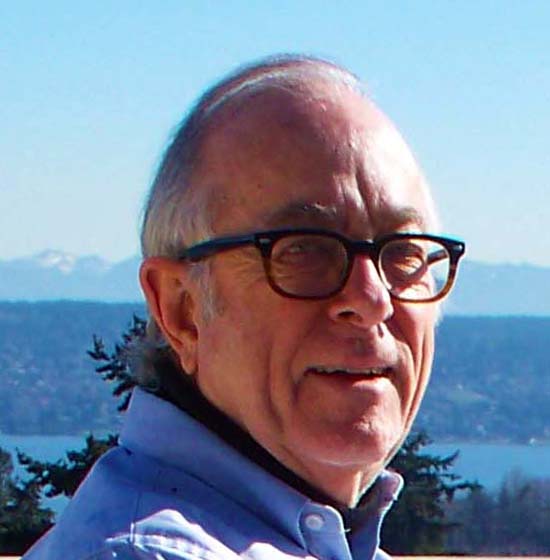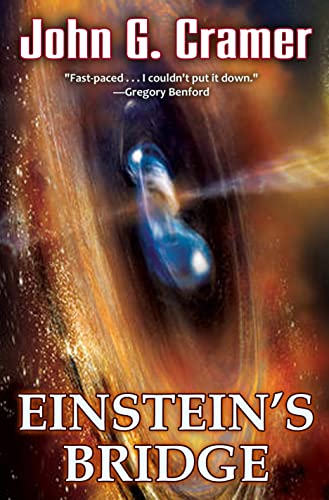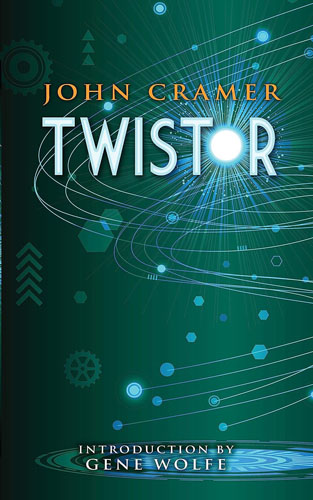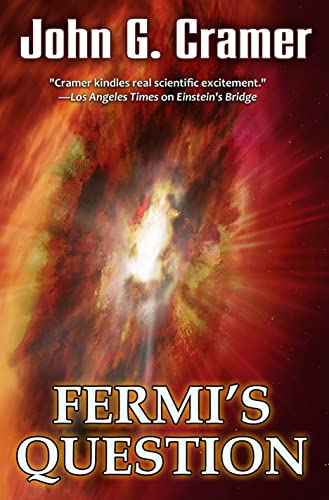A
Novel of Hard Science Fiction
by John
Cramer
Ebook: $6.99
Somewhere in the Multiverse, in a lab distant
from the Makersí Planet, Tunnel Maker, Creator of Bridges, answers an alarm.
His inter-universe probe is detecting signals from another bubble universe,
indicating that some new high-intelligence alien species is doing high-energy
physics and creating hyperdimensional signals. Tunnel Maker knows that, in
another bubble universe, the predatory Hive Mind should be receiving the same
signals. It is time to make a Bridge . . .
George Griffin, experimental physicist working
at the newly operational Superconducting Super Collider (SSC), observes a
proton-proton collision that doesnít make sense. He chases it down and
discovers a Bridgehead, a wormhole link to the Makersí universe. With help
from theorist Roger Coulton and writer Alice Lancaster, he establishes
communication with the Makers, only to learn that a Hive invasion of Earth is
imminent. As the Hive invasion is destroying humanity, by wormhole the Makers
transport George and Roger back to 1987, where they must undertake the task of
manipulating the Reagan, Bush, and Clinton administrations to change the
future and prevent construction of the SSC.
Order from
Baen Books at: https://www.baen.com/einstein-s-bridge.html
.
Order from Amazon at: https://www.amazon.com/Einsteins-Bridge-John-Cramer-ebook/dp/B0BZQR8CPK
.
Publication History:
- Einstein's Bridge,
Avon Books, (1998) mass-market paperback, about 300p., ISBN: 0-380-78831-4; List price $3.99 (Out
of Print)
-
Einstein's Bridge,
Avon Books, (1997) trade paperback, 368p., ISBN: 0-380-79279-6; List price $13.00 (Out
of Print)
-
Einstein's Bridge,
Avon Books, (1997) hardcover, 368p., ISBN: 0-380-97510-6; List price $23.00 (Out
of Print)
Note: Only 1,000 copies of the hardcover edition were published by Avon, because
the trade paperback was published simultaneously, Therefore the
hardcover edition sold out two months after publication, was not
reprinted, and has become a collector's item.
-
Einstein's Bridge, Book
View Cafť, (2013) eBook in .epub and .mobi forms, ISBN:
978-1-61138-298-3; List price $4.99
-
Einstein's Bridge, Baen
Books, (2023) eBook, eISBN: 978-1-62579-926-5; List price $6.99
Here's the first chapter of Einstein's Bridge, as provided by Avon.
Here's a review of Einstein's Bridge from the SF Site: https://www.sfsite.com/05b/bridge01.htm
.
Here's the review of Einstein's Bridge from Kirkus Reviews, 04/30/97:
 Arriving too late for a full review, physicist-author Cramer's latest hard
science fiction yarn (Twistor, 1989) begins in an alternate ``bubble''
universe where the Superconducting Super Collider (SSC) project
didn't collapse through lack of funding in the 1990s. Instead, in 2004, the
search for the elusive Higgs boson begins -- but the operation of the
SSC inadvertently sends a signal into another bubble universe, this
inhabited by the malignant and utterly ruthless Hive, who colonize new
universes by completely obliterating the competition. Fortunately, the
benevolent Makers also receive the signal and send a message back
alerting Earth to the danger. Cramer splendidly demonstrates just how
fascinating and mind- boggling real science can be, and shows exactly
how vulnerable basic research is to political whim.
Arriving too late for a full review, physicist-author Cramer's latest hard
science fiction yarn (Twistor, 1989) begins in an alternate ``bubble''
universe where the Superconducting Super Collider (SSC) project
didn't collapse through lack of funding in the 1990s. Instead, in 2004, the
search for the elusive Higgs boson begins -- but the operation of the
SSC inadvertently sends a signal into another bubble universe, this
inhabited by the malignant and utterly ruthless Hive, who colonize new
universes by completely obliterating the competition. Fortunately, the
benevolent Makers also receive the signal and send a message back
alerting Earth to the danger. Cramer splendidly demonstrates just how
fascinating and mind- boggling real science can be, and shows exactly
how vulnerable basic research is to political whim.
Copyright 1997, Kirkus Associates, LP. All rights reserved.
 This is the listing for Einstein's Bridge from the
catalog of Avon Books.
This is the listing for Einstein's Bridge from the
catalog of Avon Books.
 An all-new tale of science and suspense that has already been
praised by best-selling author David Brin as "an intriguing look
into the world of high-tech physics -- and high energy
imagination."
An all-new tale of science and suspense that has already been
praised by best-selling author David Brin as "an intriguing look
into the world of high-tech physics -- and high energy
imagination."
EINSTEIN'S BRIDGE
John Cramer
 In 1989, world-renowned physicist John Cramer burst on the science
fiction scene with his brilliantly inventive high-tech thriller
Twistor. That novel garnered admiration and accolades
from SF fans, the science community, and general readers alike
for its intriguing plot, rapid-fire pace, and heartstopping
suspense. Now Cramer does it again, with an all new high-wire
science thriller.
In 1989, world-renowned physicist John Cramer burst on the science
fiction scene with his brilliantly inventive high-tech thriller
Twistor. That novel garnered admiration and accolades
from SF fans, the science community, and general readers alike
for its intriguing plot, rapid-fire pace, and heartstopping
suspense. Now Cramer does it again, with an all new high-wire
science thriller.
 It is the year 2004. Two physicists and a writer are drawn
together at the site of the giant Superconducting Super Collider
-- a particle accelerator recently completed in the Texas outback.
When the high-energy experiments produce an unexpected anomaly,
they are the first to realize that it is a communication from
another universe. Too late, they decipher the warning from
an alien life form who informs them that yet another, hostile,
intelligence known simply as "The Hive" will also respond to
Earth's signals. For, The Hive combs the cosmos, seeking
intelligent life, establishing communications and, once it has
learned all it can, destroys.
It is the year 2004. Two physicists and a writer are drawn
together at the site of the giant Superconducting Super Collider
-- a particle accelerator recently completed in the Texas outback.
When the high-energy experiments produce an unexpected anomaly,
they are the first to realize that it is a communication from
another universe. Too late, they decipher the warning from
an alien life form who informs them that yet another, hostile,
intelligence known simply as "The Hive" will also respond to
Earth's signals. For, The Hive combs the cosmos, seeking
intelligent life, establishing communications and, once it has
learned all it can, destroys.
 An ingenious mix of real-life science and vivid drama, EINSTEIN'S
BRIDGE is an edge-of-your-seat voyage through space, time, and
imagination.
An ingenious mix of real-life science and vivid drama, EINSTEIN'S
BRIDGE is an edge-of-your-seat voyage through space, time, and
imagination.
 "A fast-paced, insider's view of how high energy physics actually
works ... I couldn't put it down."--Gregory Benford
"A fast-paced, insider's view of how high energy physics actually
works ... I couldn't put it down."--Gregory Benford
 "A fascinating look at how real science and the associated
politics work...[and] marvelous speculation about the possibilities
out at the cutting edge."--Poul Anderson
"A fascinating look at how real science and the associated
politics work...[and] marvelous speculation about the possibilities
out at the cutting edge."--Poul Anderson
 John Cramer is a professor of physics at the University of
Washington. He writes the bi-monthly science column for
Analog Magazine. He divides his time between his home
in Seattle, and Switzerland, where he is involved in work on
the particle accelerator at CERN.
John Cramer is a professor of physics at the University of
Washington. He writes the bi-monthly science column for
Analog Magazine. He divides his time between his home
in Seattle, and Switzerland, where he is involved in work on
the particle accelerator at CERN.
June 1997
368 pp.
Science Fiction
An Avon Original
![[Einstein's Bridge cover]](./About Einstein's Bridge_files/eb_t.jpg)
|
This is the Einstein's Bridge book jacket from the original Avon
hardcover and trade paperback editions (1997).
Click on the icon for a larger (25k) image.
|
![[Einstein's Bridge cover]](G2/EB-cover.jpg)
|
This is the Einstein's Bridge book jacket from the Baen Books eBook
edition (2023).
Click on the icon for a larger (25k) image.
|
This is a summary of Einstein's Bridge that was written
when the novel was being offered to Avon in 1995.
 Einstein's Bridge (130,000 words) is a hard science
fiction novel about about high energy physics, wormholes, alien
contact, time travel, and the killing of the Superconducting
Super Collider (SSC) Project. It is set Waxahachie, Texas in the year
2004 when the Superconducting Super Collider, an $8 billion high
energy particle accelerator, has just come into operation. The
SSC collides two 200 TeV beams of protons, producing
concentrations of energy that have not occurred since the early
Big Bang. Unknown to the SSC physicists, these collisions
produce signals detected by two warring alien civilizations, one
benevolent and the other hostile. These aliens are isolated in
universes that split off from ours in the Big Bang. They both
use wormholes (the "bridge" of the title) to make contact with
intelligent life in other universes. The benevolent aliens
contact SSC scientists, warn them, and try to help them defend
our world from colonization by the hostile aliens, but they are
too late. The only remaining way of defeating the alien invaders
is to intentionally destroy our own universe - "unravel" it
actually - back to a time before the SSC began to operate. Two
protagonists are thrown backwards in time to 1987; their mission:
to stop the SSC project before history repeats itself.
Einstein's Bridge (130,000 words) is a hard science
fiction novel about about high energy physics, wormholes, alien
contact, time travel, and the killing of the Superconducting
Super Collider (SSC) Project. It is set Waxahachie, Texas in the year
2004 when the Superconducting Super Collider, an $8 billion high
energy particle accelerator, has just come into operation. The
SSC collides two 200 TeV beams of protons, producing
concentrations of energy that have not occurred since the early
Big Bang. Unknown to the SSC physicists, these collisions
produce signals detected by two warring alien civilizations, one
benevolent and the other hostile. These aliens are isolated in
universes that split off from ours in the Big Bang. They both
use wormholes (the "bridge" of the title) to make contact with
intelligent life in other universes. The benevolent aliens
contact SSC scientists, warn them, and try to help them defend
our world from colonization by the hostile aliens, but they are
too late. The only remaining way of defeating the alien invaders
is to intentionally destroy our own universe - "unravel" it
actually - back to a time before the SSC began to operate. Two
protagonists are thrown backwards in time to 1987; their mission:
to stop the SSC project before history repeats itself.
 Einstein's Bridge is a "novel of discovery", in that much
of the action involves scientific detective work and problem
solving. It is a "novel of ideas", because scientific concepts,
theories, and ideas are essential to the story. The novel has
strong, fully-developed characters which are necessary for this
story, but unusual in hard SF. The portrayal of Texas culture
and physics culture both come from the author's personal
experience. He was born in Houston and lived in Texas for the
first 26 years of his life. His portrayal of high energy physics
and the SSC laboratory is based on his work in relativistic heavy
ion physics at the CERN laboratory, his study of the planning for
the SSC, and personal interviews in Waxahachie during the early
stages of the SSC project.
Einstein's Bridge is a "novel of discovery", in that much
of the action involves scientific detective work and problem
solving. It is a "novel of ideas", because scientific concepts,
theories, and ideas are essential to the story. The novel has
strong, fully-developed characters which are necessary for this
story, but unusual in hard SF. The portrayal of Texas culture
and physics culture both come from the author's personal
experience. He was born in Houston and lived in Texas for the
first 26 years of his life. His portrayal of high energy physics
and the SSC laboratory is based on his work in relativistic heavy
ion physics at the CERN laboratory, his study of the planning for
the SSC, and personal interviews in Waxahachie during the early
stages of the SSC project.
 The last part of the novel is also unusual, perhaps unique in
SF, because real events and political actions between 1987 and the
present are fictionalized and given new significance and meaning by
the plot. The author's portrayal of the inner workings of national
politics also comes from personal experience in presenting the case
for the value of basic research to members of several Administrations
and to members of Congress and their staff. Media reports were
studied in detail for the period from 1987, when the SSC project was
announced by Reagan, to 1993 when the project was killed by the US
Congress. Quotations used on the part number pages are usually taken
from Science, Nature, Physics Today, or the American Physical
Society's "What's New" electronic newsletter.
The last part of the novel is also unusual, perhaps unique in
SF, because real events and political actions between 1987 and the
present are fictionalized and given new significance and meaning by
the plot. The author's portrayal of the inner workings of national
politics also comes from personal experience in presenting the case
for the value of basic research to members of several Administrations
and to members of Congress and their staff. Media reports were
studied in detail for the period from 1987, when the SSC project was
announced by Reagan, to 1993 when the project was killed by the US
Congress. Quotations used on the part number pages are usually taken
from Science, Nature, Physics Today, or the American Physical
Society's "What's New" electronic newsletter.
 Einstein's Bridge is John Cramer's second novel. It may be
compared to his first novel,Twistor, which received very favorable
reviews, was nominated for several awards, and was commercially
successful, with SF Book Club and British editions and a new (1996)
Japanese edition from Hayakawa. Both works are novels of discovery in which the
principal protagonist is a physicist who makes an important and
unexpected discovery. Both use scientific problem solving as an
important plot element. Both have strong characterization. Both, in
fact, involve other universes, but in very different ways.
The novels differ in that Twistor
was about small-scale condensed-matter physics
research in a university laboratory, while Einstein's Bridge is
played on the broader stage of national politics and of high energy
physics, with its multi-billion dollar accelerators and teams of a
thousand physicists working together to discover the inner secrets of
the universe.
Einstein's Bridge is John Cramer's second novel. It may be
compared to his first novel,Twistor, which received very favorable
reviews, was nominated for several awards, and was commercially
successful, with SF Book Club and British editions and a new (1996)
Japanese edition from Hayakawa. Both works are novels of discovery in which the
principal protagonist is a physicist who makes an important and
unexpected discovery. Both use scientific problem solving as an
important plot element. Both have strong characterization. Both, in
fact, involve other universes, but in very different ways.
The novels differ in that Twistor
was about small-scale condensed-matter physics
research in a university laboratory, while Einstein's Bridge is
played on the broader stage of national politics and of high energy
physics, with its multi-billion dollar accelerators and teams of a
thousand physicists working together to discover the inner secrets of
the universe.
 John G. Cramer
John G. Cramer
Reader Reviews from Amazon
(Rating: 4.1 stars)
William
J. Boyd
5.0
out of 5 stars
Very Entertaining SCI-FI Novel!!
Reviewed
in the United States on July 31, 2021
Verified Purchase
Very difficult book to find, but one of my favorite sci-fi novels.
If you understand anything about
Superconducting Super Colliders, this book will be very entertaining. Sheldon
Cooper (Big Bang Theory) would find this most entertaining. It
takes the SSC project that was being built in Texas, but funding was
unfortunately canceled by Congress in 1993, a horrible mistake that turned high
energy particle physics research leadership to the Europeans and the Large
Hadron Collider, the most powerful particle accelerator ever built, in CERN,
Switzerland. Anyway, the book
follows the completion of the SSC in Texas and opens a subspace signal picked up
by a war- like race of aliens that started the enslavement of the human species.
Iíll stop there. But it is very
sci-fi entertaining. Unfortunately, it never made it to audio books.
Jackie
5.0
out of 5 stars
Extremely enjoyable--I loved it!
Reviewed
in the United States on November 19, 2004
Verified Purchase
Believe it or not, it was the Acknowledgements that made me buy Einstein's
Bridge. John Cramer wrote
that when the Superconducting Super Collider project was scrapped in 1993, it
was a year before he could bear to look at his unfinished manuscript. I
"felt his pain." Those who have an interest in particle physics will
especially enjoy this book, although I think any fan of hard sci-fi will be
delighted with it. The characters are great--likable and believable. The real
beauty of this book is its highly original plot. The backdrop is Waxahachie,
Texas, (yes, that was to be the SSC site) in the first decade of the 21st
Century -- in other words, 'bout now. Our
high-energy physics experiments have attracted notice of two different groups of
aliens. We have the bad guys, who invade and take over other worlds, and the
good guys, who empower other civilizations to defeat the bad guys before the
invasion can be completed. They do
this by contacting us and teaching us to "read" and "write."
(These words will never have the same mundane meaning to you again after this
book!) There is plenty of good
science mixed in with the fiction, and enough twists to keep you wondering how
on earth it will resolve itself. Much to my delight, time travel was even
introduced. I don't want to say
more, as it would spoil the plot. This book takes you along on a great
ride--enjoy it!
Kindle
Customer
5.0
out of 5 stars
Not just for high energy physics junkies...
Reviewed
in the United States on January 6, 2006
Verified Purchase
All right, so if you were ever involved with high energy physics [I was],
and especially if you're American [I'm not], this is going to remind you of lot
of things, even if you've missed the latest developments (basic string theory
all right? QCD is now obsolete, in
case you hadn't noticed. Bubbles, bubbles, anybody remembers bubble chambers?).
Dr. Cramer's gift
is to be able to paint skillfully the inside of a modern physics lab ten years
ago, the hierarchical pecking order therein, going down from top dog - the head
of a facility - to the electrician servicing some parts of an experiment, and
shows them as people, with the complex pattern of their relations, not as empty
formula-spouting cardboard characters, which is unfortunately so often the doom
of the not-too-crafty hard science fiction writer, even when the author is a
scientist.
Dr. Cramer shows
also a more-than-basic knowledge of the legislative arm of the US federal
government, and effectively describes some of its failings, as well as the
mystique in "science research financing" which actually is pork in
disguise, in a fairly interesting way.
Also, his
physics is good and it takes a reasonably good experimental physicist (alas, I
no longer am) to understand when he deviates from real science to fairy tale
(though at least partially credible).
I am sure this
will appeal to all scientists who read SF (I admit being one), but its ease of
writing, its 3D characters and the plot twists should reach beyond this
specialized audience.
Excellent
book, entertaining and as good or even better than "Twistor".
A must for
the hard SF fan.
Danny
Matson
5.0
out of 5 stars
Science Fiction, with a heavy emphasis on both. Recommended!
Reviewed
in the United States on September 19, 2018
Verified Purchase
I don't know how many times I read and enjoyed this novel when it came
out 19 years ago. I lent my copy to someone who moved on and didn't return it
(perhaps I did the same with one of his!), so recently when I got the itch to
re-visit the story I was lucky enough to find a very good and affordable used
copy.
The concept is
ingenious, the plot brilliantly presented. I find both the science and the
fiction to be deeply involving.
Central
characters (except for the villains) are all likable and relatable. The
historical facts are deftly integrated with the fiction, and the author's
afterword teases them out from each other in an honest and helpful manner.
Noel
Cramer
5.0
out of 5 stars
A hard science novel that reads like an adventure story
Reviewed
in the United States on August 27, 1997
Verified Purchase
After having enjoyed Twistor some years ago, I have been
waiting for a possible sequel to that novel. The
tantalizing glimpse of an alien world accessible through a "gateway"
bore the promise of much adventure.
Einstein's
Bridge is certainly no sequel to that book, though the concept of
parallel universes also forms its basis. It is an exceptionally good "hard
science" story. The physics is
credible and presented with such clarity that very few readers will be
discouraged. They will indeed learn
quite a lot about high energy physics along the way and gain much insight
concerning the way scientific research is done and how the related
"politics" works. The
characterization of the protagonists is good, the plot is excellent for its
rigor and unpredictability. There
are some truly terrifying moments (when the "Hive" is found and breaks
loose) that have the same kind of impact as the claustrophobic anguish of being
embedded inside a tree in Twistor. Like
in that novel, the ending is also open, though more ominous ...
An exciting
adventure that no reader will ever forget. I
thoroughly enjoyed this book, and encourage the author to continue practicing
his considerable talent for SF. He
can at least count on one unconditional reader of his next novel: me!
This page was created by John G. Cramer
on 7/10/96 and revised on 07/04/2023


 Arriving too late for a full review, physicist-author Cramer's latest hard
science fiction yarn (Twistor, 1989) begins in an alternate ``bubble''
universe where the Superconducting Super Collider (SSC) project
didn't collapse through lack of funding in the 1990s. Instead, in 2004, the
search for the elusive Higgs boson begins -- but the operation of the
SSC inadvertently sends a signal into another bubble universe, this
inhabited by the malignant and utterly ruthless Hive, who colonize new
universes by completely obliterating the competition. Fortunately, the
benevolent Makers also receive the signal and send a message back
alerting Earth to the danger. Cramer splendidly demonstrates just how
fascinating and mind- boggling real science can be, and shows exactly
how vulnerable basic research is to political whim.
Arriving too late for a full review, physicist-author Cramer's latest hard
science fiction yarn (Twistor, 1989) begins in an alternate ``bubble''
universe where the Superconducting Super Collider (SSC) project
didn't collapse through lack of funding in the 1990s. Instead, in 2004, the
search for the elusive Higgs boson begins -- but the operation of the
SSC inadvertently sends a signal into another bubble universe, this
inhabited by the malignant and utterly ruthless Hive, who colonize new
universes by completely obliterating the competition. Fortunately, the
benevolent Makers also receive the signal and send a message back
alerting Earth to the danger. Cramer splendidly demonstrates just how
fascinating and mind- boggling real science can be, and shows exactly
how vulnerable basic research is to political whim.
![[Einstein's Bridge cover]](./About Einstein's Bridge_files/eb_t.jpg)
![[Home]](./About Einstein's Bridge_files/home.gif)


![[Mailbox]](G2/flagup.gif)